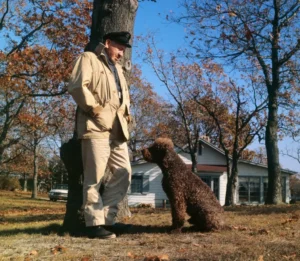
Another of my listens while exercising at the local Y. Here’s my pitch: Don’t be swayed away from this great piece of writing by those who have panned the book, including Bill Steigerwald’s “exposés” concerning the narrative and timeline that form this travelogue. This is an exemplary piece of “road writing”, one that lays out an America Steinbeck encountered when he packed up his pickup truck and its camper, placed his standard poodle Charley in the cab’s passenger seat, and set off to explore his native country.
Steinbeck spent his youth and much of his adulthood in California and New York. The journey he depicts in Travels starts on Long Island and ends there as well. In between, the author navigates two-lanes, and the occasional expressway, from Maine to the West Coast, through Texas and the Deep South, before returning home. The ending will bring a smile to your face so I won’t spoil it here. But the storytelling to be found in Steinbeck’s greatest prose, Grapes of Wrath, East of Eden, Of Mice and Men is on full display here. Critics, like Steigerwald, who pan the itinerary and factual basis of these terrific essays, miss the entire point of the book. Who cares if Steinbeck met or didn’t meet the folks he portrays? Who cares if he spent more nights in motels and hotels than roughing it in his camper? The yarns he tells and the landscapes he paints give us a glimpse of the America he discovered along the way: the beautiful and the ugly; the kind and the racist; the confined countryside (New England) and the breadth of the West (especially Montana, his favorite state).
In particular, his depiction of the sadness and the anger he witnessed in the Deep South, where he drove smack dab into the midst of Dr. King and the Civil Rights Movement, are touching, telling, and fist-wrenching. Steinbeck’s recounting tale of watching a young Negro (his term, not mine) girl, a “mite of a thing” as he puts it, being escorted from a federal marshal’s car by big, burly, serious white men who are there to protect her from “the Cheerleaders” (white mothers and grandmothers who scream at the little girl) inside a formerly all-white elementary school in Louisiana) is the best of the lot. Whether the event happened exactly as depicted, on the day depicted, or whether it’s a collage of what the author read in local newspapers or saw on the local news during his travels isn’t of interest to me. I’m interested in the larger story, real or imagined, placed upon the page by one of our greatest 20th century writer commenting on America and the Americans he may have (or may not have) met and distilled.
Readers and Steinbeck scholars who attack the “facts” contained in this work need to understand: this is memoir, the blending of fact and lyrical narrative that may or may not be exactly so. In my own memoir, Duck and Cover, I have hundreds of conversations in quotations and recount a similar plethora of events I believe I experienced during the beginning stages of my life. That such dialogue, settings, and events portrayed may not have happened exactly as I recall or depict doesn’t diminish the truth of my story. In similar fashion, the larger truths of Steinbeck’s travel memoir must be read with the same eye.
The fact that Gary Sinese is the narrator of the Audibile version of the book only adds frosting to this finely baked cake of a travel story.
5 stars out of 5. Don’t listen to the detractors.
Peace
Mark



